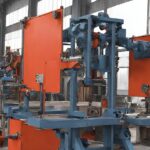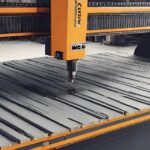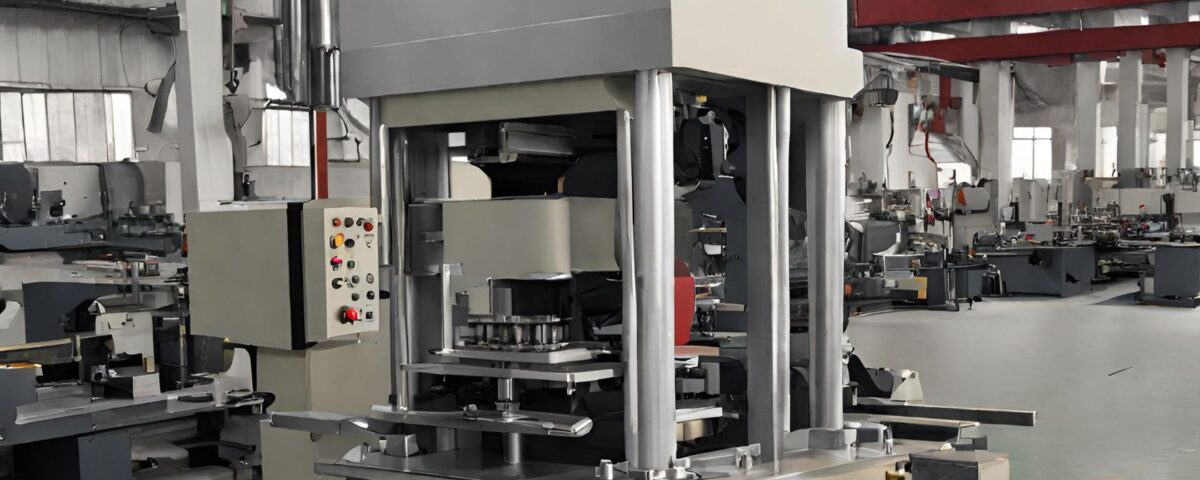
Mastering the Art of Aluminum Casting for Stunning Results
23 April 2024
The correlation and calculation method of cutting speed, cutting amount and feed speed
26 April 2024Aluminium stamping is transforming the landscape of manufacturing processes, offering businesses unparalleled opportunities for growth and efficiency. With its precision and versatility, aluminium stamping unlocks a world of possibilities for various industries, including automotive, aerospace, and electronics.
In this article, we delve into the revolutionary benefits of aluminium stamping and its impact on manufacturing. By harnessing the power of this advanced technique, companies can achieve higher productivity, reduce costs, and enhance product quality. From intricate designs to complex shapes, aluminium stamping enables manufacturers to meet the ever-evolving demands of consumers.
Moreover, aluminium's lightweight yet durable nature makes it an ideal choice for industries where weight reduction, strength, and corrosion resistance are crucial. Whether it's for automotive body panels, aircraft components, or electronic enclosures, aluminium stamping allows for the production of lightweight yet robust parts, offering improved fuel efficiency and performance.
Join us as we explore how aluminium stamping is revolutionizing manufacturing processes, providing businesses with the means to unlock their fullest potential and stay ahead in today's competitive market.
Advantages of Aluminium Stamping in Manufacturing
Aluminium stamping offers numerous advantages that make it a game-changer in the manufacturing industry. Firstly, aluminium's high strength-to-weight ratio makes it an excellent choice for industries that require lightweight yet durable components. The lightweight nature of aluminium reduces fuel consumption in the automotive sector and enhances overall efficiency in aerospace applications. Moreover, aluminium's corrosion resistance properties ensure the longevity of stamped parts, reducing maintenance costs in the long run.
Secondly, aluminium stamping enables the production of intricate designs and complex shapes. The precision and versatility of the stamping process allow manufacturers to create parts with tight tolerances, ensuring a perfect fit and optimal performance. Whether it's for automotive body panels with intricate curves or electronic enclosures with precise openings for components, aluminium stamping delivers exceptional results.
Furthermore, aluminium stamping offers faster production cycles compared to traditional manufacturing methods. The stamping process can be automated, allowing for high-volume production with minimal human intervention. This not only improves productivity but also reduces labor costs and minimizes the risk of errors. With aluminium stamping, manufacturers can meet tight deadlines and fulfill large orders efficiently.
In summary, the advantages of aluminium stamping in manufacturing include its lightweight yet durable nature, the ability to produce intricate designs and complex shapes, and faster production cycles. These advantages position aluminium stamping as a preferred choice for industries looking to optimize their manufacturing processes and achieve competitive advantages.

The Process of Aluminium Stamping
Aluminium stamping involves a series of steps that transform a flat sheet of aluminium into a finished part. Let's take a closer look at the process:
- Design and Tooling: The first step in aluminium stamping is the design and tooling phase. Manufacturers work closely with design engineers to develop the desired part geometry. Once the design is finalized, specialized tooling is created, including dies and punches, to shape the aluminium sheet.
- Material Selection: Choosing the right aluminium alloy is crucial for the stamping process. The alloy's mechanical properties, such as strength, ductility, and formability, must be considered to ensure optimal results. Different aluminium alloys are suitable for various applications, and manufacturers select the appropriate alloy based on the specific requirements of the part.
- Sheet Preparation: Before the stamping process begins, the aluminium sheet undergoes preparation, including cleaning and lubrication. Cleaning removes any contaminants that may affect the stamping process, while lubrication reduces friction between the sheet and the stamping tools, allowing for smoother and more efficient stamping.
- Stamping Process: The actual stamping process involves placing the prepared aluminium sheet onto a stamping press. The press applies force to the sheet, causing it to deform and take the shape of the dies and punches. This deformation can include bending, stretching, or even piercing, depending on the desired part.
- Finishing Operations: Once the stamping process is complete, additional finishing operations may be required. These operations may include trimming excess material, deburring sharp edges, or applying surface treatments such as painting or anodizing. These finishing touches ensure the final part meets the required specifications and aesthetics.
The process of aluminium stamping is a precise and efficient method of transforming flat aluminium sheets into complex and functional parts. By following the steps mentioned above, manufacturers can unlock the full potential of aluminium stamping and achieve high-quality results.
Common Applications of Aluminium Stamping
The versatility of aluminium stamping opens up a wide range of applications across various industries. Some of the common applications of aluminium stamping include:
| Industry | Applications | Benefits |
|---|---|---|
| Automotive | Body panels, structural components, engine parts | Lightweight yet strong parts, improved fuel efficiency, enhanced performance, intricate designs, complex shapes, meets aesthetic requirements |
| Aerospace | Wing panels, fuselage parts, interior components | Lightweight aircraft components, no compromise on strength and durability, revolutionizes manufacturing process, fuel efficiency, cost savings |
| Electronics/Telecom | Electronic enclosures, heat sinks, connectors, PCBs | Lightweight, intricate designs, precise openings for components, optimal functionality, thermal management |
| Consumer Goods | Household appliances, consumer electronics, sporting goods | Versatility, complex shapes and designs, enhanced functionality and aesthetics, lightweight, portability, user-friendly |
| Construction | Architectural elements, HVAC components, structural supports | Strength, durability, corrosion resistance, lightweight, design flexibility, energy efficiency |
| Medical | Medical devices, equipment housings, surgical instruments | Biocompatibility, lightweight, precision manufacturing, corrosion resistance, ease of sterilization, design flexibility, improved patient outcomes |
| Packaging | Food packaging, beverage containers, cosmetic packaging | Lightweight, recyclable, corrosion resistance, barrier properties, customizable designs, extends shelf life, reduces transportation costs |
| Energy | Solar panels, wind turbine components, battery casings | Lightweight, corrosion resistance, durability, enhances energy efficiency, reduces carbon footprint, promotes renewable energy adoption |
| Defense | Military vehicles, armor plating, munitions | Lightweight, high strength-to-weight ratio, ballistic resistance, durability, improves mobility and agility, enhances soldier safety |
| Marine | Boat hulls, marine structures, offshore platforms | Corrosion resistance, lightweight, durability, buoyancy, reduces fuel consumption, enhances performance in marine environments |
| Agriculture | Farm equipment, irrigation systems, greenhouse structures | Lightweight, corrosion resistance, durability, enhances agricultural productivity, reduces maintenance costs, promotes sustainable farming practices |
These are just a few examples of the wide-ranging applications of aluminium stamping. As manufacturers continue to explore the capabilities of aluminium stamping, its potential in different industries will only continue to expand.

Case Studies: How Aluminium Stamping Has Revolutionized Specific Industries
Aluminium stamping has revolutionized specific industries by offering innovative solutions and unlocking new possibilities. Let's explore some case studies that demonstrate the transformative impact of aluminium stamping:
In the Automotive Industry, Tesla, a leading electric vehicle manufacturer, has leveraged aluminium stamping to enhance the performance and efficiency of its vehicles. By utilizing aluminium stamping for body panels and structural components, Tesla has achieved significant weight reduction, improving the range and overall efficiency of their electric vehicles. The precision and versatility of aluminium stamping have allowed Tesla to create sleek and aerodynamic designs, setting them apart in the automotive market.
In the Aerospace Sector, Boeing, one of the world's largest aerospace companies, has embraced aluminium stamping to optimize the manufacturing of aircraft components. By utilizing aluminium stamping techniques, Boeing has reduced the weight of critical aircraft parts, resulting in improved fuel efficiency and increased payload capacity. Aluminium stamping has also enabled Boeing to produce parts with complex geometries, enhancing the aerodynamic performance of their aircraft.
In the Electronics Industry, Apple, a renowned technology company, has incorporated aluminium stamping into its product manufacturing processes. From MacBook casings to iPhone frames, aluminium stamping allows Apple to create lightweight yet strong components that contribute to the sleek design and durability of their devices. The precise and intricate designs made possible by aluminium stamping align with Apple's commitment to excellence in both aesthetics and functionality.
These case studies highlight how aluminium stamping has revolutionized specific industries by enabling weight reduction, enhancing performance, and achieving complex designs. By embracing aluminium stamping, companies can stay at the forefront of innovation and meet the evolving demands of their customers.
Innovations in Aluminium Stamping Technology
As technology continues to advance, so does the field of aluminium stamping. Innovations in aluminium stamping technology have further enhanced the capabilities and efficiency of the process. Let's explore some notable innovations in aluminium stamping:
- High-Speed Stamping: High-speed stamping technology allows for faster production cycles, increasing productivity and reducing lead times. This technology incorporates advanced press controls and high-speed feeding systems, enabling manufacturers to achieve high-volume stamping with precision and efficiency.
- Simultaneous Multiple Operations: Simultaneous multiple operations refer to the ability to perform multiple stamping operations on a single press stroke. By integrating multiple dies and punches in a single tool, manufacturers can save time and increase overall productivity. Simultaneous multiple operations also reduce the number of press strokes required, resulting in improved efficiency.
- Advanced Die Materials: The development of advanced die materials, such as carbide and high-speed steel, has significantly improved the durability and wear resistance of stamping tools. These materials can withstand high pressures and temperatures, allowing for extended tool life and reduced downtime for maintenance.
- Computer-Aided Design and Simulation: Computer-aided design (CAD) and simulation software have revolutionized the design and validation of stamped parts. These tools enable manufacturers to create virtual prototypes, simulate stamping processes, and analyze the performance of the parts before physical production. This reduces the risk of errors, optimizes tooling designs, and minimizes material waste.
These innovations in aluminium stamping technology have further expanded the possibilities and efficiency of the process. By embracing these advancements, manufacturers can unlock new levels of productivity, precision, and cost-effectiveness in their stamping operations.
Choosing the Right Aluminium Stamping Partner
Choosing the right aluminium stamping partner is crucial for successful manufacturing operations. Here are some key factors to consider when selecting an aluminium stamping partner:
- Experience and Expertise: Look for a stamping partner with extensive experience and expertise in aluminium stamping. A partner who understands the unique requirements and challenges of the process can provide valuable insights and deliver high-quality results.
- Capabilities and Equipment: Assess the capabilities and equipment of potential stamping partners. Ensure they have the necessary machinery, tooling, and quality control measures in place to meet your specific requirements.
- Material Knowledge: Verify that your stamping partner has in-depth knowledge of different aluminium alloys and their properties. A partner who can guide you in selecting the most suitable alloy for your parts can help optimize the stamping process and achieve desired outcomes.
- Quality Control: Quality control is crucial in aluminium stamping to ensure the production of defect-free parts. Confirm that the stamping partner has robust quality control processes in place to consistently deliver high-quality stamped parts.
- Collaboration and Communication: Effective collaboration and communication are essential when working with a stamping partner. Choose a partner who values open communication and is responsive to your needs and concerns.
By carefully evaluating these factors, you can select an aluminium stamping partner that aligns with your requirements and supports your manufacturing goals.
Cost Considerations and ROI of Aluminium Stamping
Cost considerations are pivotal in the decision-making process surrounding the adoption of aluminium stamping. Despite potentially higher initial costs compared to traditional manufacturing methods, aluminium stamping presents long-term benefits and a favorable return on investment (ROI). Exploring the cost considerations and ROI of aluminium stamping reveals its economic viability.
Tooling costs represent a significant initial investment in aluminium stamping. However, these costs are amortized across the production volume, rendering aluminium stamping more cost-effective for large-scale manufacturing. Moreover, the durability and extended tool life of stamping tools minimize maintenance and replacement expenses over time. Material costs in aluminium stamping are influenced by the higher price of aluminium raw material. Nonetheless, the lightweight nature of aluminium reduces material consumption, counterbalancing the higher material costs and resulting in overall cost savings. Additionally, lightweight components contribute to further savings in transportation and energy consumption.
Labour costs are substantially reduced in aluminium stamping compared to traditional methods. Automation of the stamping process diminishes the need for manual labour, thereby decreasing associated expenses. Furthermore, automation enhances productivity, reduces the likelihood of errors, and ultimately leads to long-term cost savings. Aluminium stamping also enhances productivity and efficiency through faster production cycles, enabling businesses to meet deadlines, fulfill large orders, and generate higher revenue. In consideration of these cost factors and the potential return on investment, aluminium stamping emerges as a cost-effective solution over time. Despite the initial investment, its benefits such as lightweight, high-strength parts, accelerated production cycles, and reduced labour costs contribute to significant overall cost savings.
Conclusion
Aluminium stamping is revolutionizing manufacturing processes across various industries, offering businesses unparalleled opportunities for growth and efficiency. The advantages of aluminium stamping, including its lightweight yet durable nature, the ability to produce intricate designs and complex shapes, and faster production cycles, position it as a preferred choice for manufacturers.
As technology continues to advance, aluminium stamping will only become more efficient and versatile. Innovations in stamping technology, such as high-speed stamping and advanced die materials, will further enhance the capabilities of aluminium stamping, allowing manufacturers to unlock new levels of productivity and precision.
To fully unlock the potential of aluminium stamping, it is crucial for manufacturers to choose the right stamping partner, considering factors such as experience, expertise, capabilities, and material knowledge. By collaborating with the right partner, businesses can optimize their stamping operations and achieve high-quality results.
While aluminium stamping may come with its challenges and initial costs, the long-term benefits and return on investment make it a cost-effective solution. The ability to reduce material consumption, labor costs, and lead times, along with the production of lightweight yet robust parts, positions aluminium stamping as a valuable asset for businesses seeking to stay ahead in today's competitive market.
As the demand for lightweight, high-performance components continues to grow, aluminium stamping will play a crucial role in shaping the future of manufacturing. By harnessing the power of aluminium stamping, businesses can unlock their fullest potential, meet the evolving demands of consumers, and achieve sustainable growth in the dynamic landscape of manufacturing.




